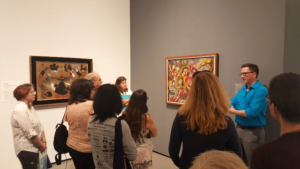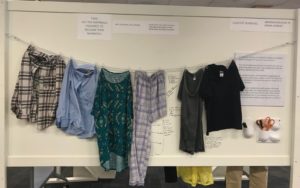For the 25th anniversary of our Chautauqua living history series, we’re diving into how water has shaped our history and celebrating those who have navigated ice, waves, and the depths below. Communications Specialist Sarah Weissman spoke with Mary Ann Jung, the actor-historian who plays “pirate queen” Grace O’Malley. Chautauqua 2019: Making Waves continues tonight and ends with a performance of Jung as O’Malley on July 20.
For performer Mary Ann Jung, who portrays “pirate queen” Grace O’Malley, donning her 16th-century garb is something akin to wearing a superhero suit. “I feel stronger in costume than out of costume,” she says. Jung’s father was in the navy, and while she’s inherited an interest in the sea, she confesses she’s not like the brave adventurer she portrays. “I wouldn’t really want to be the sailor.”

Jung expresses an admiration, ownership, and closeness to “all my amazing women,” referring not only to O’Malley but others in her Chautauqua repertoire. She’s previously performed as Clara Barton, Rosalie Stier Calvert, Julia Child, and Amelia Earhart for Maryland Humanities, and as Sally Ride, Rosie the Riveter, and more elsewhere.
“It always humbles me, to be honest, to play any of these terrific role models. Even when society said ‘No you can’t,’ [they] said ‘Yes I will. I will do whatever is required, take over my father’s clan, herds, soldiers…,’ she says, referring specifically to events in O’Malley’s life. “She said ‘I want to learn’ and society laughed at her.” Yet, O’Malley didn’t let critics defeat her and went on to command the west coast of Ireland and an entire fleet of ships in the 1500s. “If she wasn’t a ferocious fighter and brilliant leader, they [her men] would’ve served somebody else,” says Jung.
“The most dangerous, brave, surprising of her actions is when in 1593 she sailed to England to face down Queen Elizabeth,” Jung says. “In order to win the release of her son, she risks her life to go to England—if anybody would have caught her, they would’ve gotten a fortune—and face down the Queen and demand justice.”

Jung also mentions Queen Elizabeth I when she bemoans that more people aren’t familiar with O’Malley. “I just wish that more people would realize that in the 1500s, much like Queen Elizabeth, there were lots of women who defied society’s narrow views of women,” she says. When first researching O’Malley, there was only one existing biography. Jung informs me that there is no painting of her, and the only physical description of her was written by an admiring anonymous Englishman. Another Englishman, soldier Richard Bingham, called O’Malley the “Nurse of All Rebellions,” and wrote to Queen Elizabeth that “Some Irish queens will submit: Grace O’Malley never, ever will.”
Jung highlights different perceptions of O’Malley. “She’s only a pirate to England, not to Ireland. To the Irish, she’s a champion,” she says. “It depends on what end of the cannon you’re looking at.”
Jung also makes sure not to paint O’Malley as universally beloved, even in her home country. “She was not fighting for all of Ireland,” she says, but “for her clan [and for] related clans,” referencing the dissension between different Irish clans at the time.

Performing in Chautauqua necessitates not only researching biographical events but the figure’s clothing, accent, and more. “In this case, I’m also researching sailing: what are the parts of a ship? What kind of ships did she sail?” The crimson skirt that gives Jung a sense of strength signifies O’Malley’s boldness: under English rule the Irish were forbidden to wear the color saffron, so “to flout the English laws,” O’Malley wore the color.
With the gaps in the known history of and public awareness surrounding O’Malley, Jung says that “I wish people knew and understood the strength and courage to do what she did.” At Maryland Humanities, we’re pleased to make O’Malley’s story a little more widely known.
Disclaimer: The views and opinions expressed on our blog do not necessarily reflect the views or position of Maryland Humanities or our funders.

















